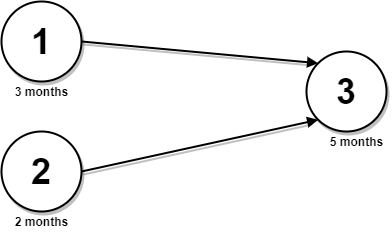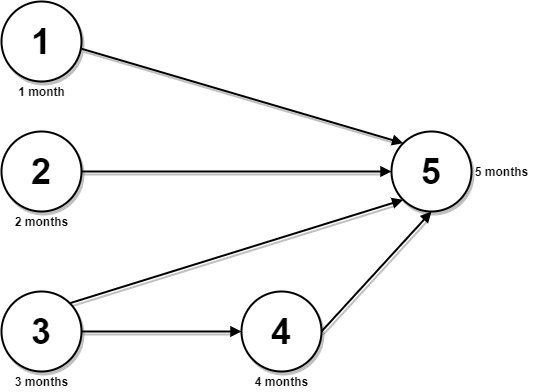2050. Parallel Courses III
Description
You are given an integer n, which indicates that there are n courses labeled from 1 to n. You are also given a 2D integer array relations where relations[j] = [prevCourse<sub>j</sub>, nextCourse<sub>j</sub>] denotes that course prevCourse<sub>j</sub> has to be completed before course nextCourse<sub>j</sub> (prerequisite relationship). Furthermore, you are given a 0-indexed integer array time where time[i] denotes how many months it takes to complete the (i+1)^th course.
You must find the minimum number of months needed to complete all the courses following these rules:
- You may start taking a course at any time if the prerequisites are met.
- Any number of courses can be taken at the same time .
Return the minimum number of months needed to complete all the courses.
Note: The test cases are generated such that it is possible to complete every course (i.e., the graph is a directed acyclic graph).
Example 1:

1 | Input: n = 3, relations = [[1,3],[2,3]], time = [3,2,5] |
Example 2:

1 | Input: n = 5, relations = [[1,5],[2,5],[3,5],[3,4],[4,5]], time = [1,2,3,4,5] |
Constraints:
1 <= n <= 5 * 10^40 <= relations.length <= min(n * (n - 1) / 2, 5 * 10^4)relations[j].length == 2- 1 <= prevCoursej, nextCoursej <= n
- prevCoursej != nextCoursej
- All the pairs [prevCoursej, nextCoursej] are unique .
time.length == n1 <= time[i] <= 10^4- The given graph is a directed acyclic graph.
Hints/Notes
- 2025/02/05 Q3
- topological sort
- 0x3F’s solution
Solution
Language: C++
1 | class Solution { |